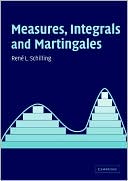

 |

|

The average rating for Measures, Integrals and Martingales based on 2 reviews is 4 stars.
Review # 1 was written on 2014-11-14 00:00:00 Serafina Greengrass Serafina GreengrassIf one is more or less serious about learning probability theory, there is no way to get around measure theory. So even though the book doesn't have the word probability (or stochastic) in its title, I believe it's a great place to get solid theoretical foundations before learning advanced probability. First, let me briefly mention the prerequisite. Unfortunately, it happens quite often that good math books get undeservingly low ratings from readers without proper background (this book is no exception; see one of the ratings on Goodreads). The major prerequisite one needs for the book is a rigorous (i.e. ε-δ-proof based) course on real analysis. There is no point attempting to work through the book without it. Secondly, I'd like to mention that the book's strategy is to focus first on abstract measure and only then to move to Lebesgue measure. I personally find this approach much more satisfactory than the converse one (which can be found in Tao's text, for example). I took a close look at over a dozen books on measure theory and have decided to stick to this one. After working with the book for a few months, I'm convinced of having made the right choice. In what follows I list the reasons I like the book. • Proofs. All proofs are very clear, at no point I was left wondering where one or another result comes from. The author generously employs the simple and powerful technique of giving references to already proven statements above the "=" signs. • Problems. The book contains over three hundred well-chosen problems. I found the set of problems to be of the right difficulty level (challenging enough to make you think and expose you to important proof techniques but totally doable). • Solutions. The webpage dedicated to the book () contains pdfs with solutions to all (!) problems and some bonus material with additional problems. The solutions are very detailed and amount to about three hundred pages. So basically, it's two books in one. • Illustrations. For some puzzling reason, many authors seem to believe that rigorous math books need no illustrations (e.g. Doob's book on measure theory contains not a single one). Yet many concepts of measure theory are very well suited for visual presentation. The book makes a good use of it by providing about three dozen illustrations which help to grasp the concepts. • Notation. I'm deeply convinced that choosing the right notation is a good portion of success in mathematical writing. Let me give you a few examples to illustrate the careful choice of notation in this book. The naming for objects is generally consistent, and, very importantly, doesn't look unnecessarily noisy: e.g. naming f and g rather than f₁ and f₂. The naming is also suggestive: e.g. in the context of Jensen's inequality V stands for convex functions and Λ for concave ones. The author uses the check mark [✓] to draw attention to simple results which still shouldn't be taken for granted and thus require some little verification from the reader. Bourbaki's 'dangerous bend' symbol ☡ indicates tricky places (my favorite one being that the statements 'f enjoys a property Π almost surely' and 'f is almost surely equal to g which satisfies Π everywhere' are, in general, far apart). • Errata. This should actually go without saying but I've seen way too many math texts with plenty of errors but no errata available. The errata to this book can be found on the book's webpage, so make sure you go through it and make changes in your version. • Organization. On the whole, the book's organization makes it a good reference guide. In particular, all definitions, theorems, corollaries, examples, and so on are numbered with the same counter. It might look like a trifle issue but if you've ever tried to navigate a text with separate counters (where Example 5.2.11 is followed by Definition 5.2.3) you must know how frustrating that is. Thus, I do recommend the book and am planning to buy several copies to give as Christmas presents (just kidding). |
Review # 2 was written on 2011-02-10 00:00:00 Erik Klueber Erik KlueberIf you are coming at these topics with an applied interest in finance or probability, you'll find this book to be a double-edged sword. The book is clearly aimed at budding mathematicians (specifically, analysts), and thus the presentation of material is very general -- Schilling looks at general measure spaces, not just probability spaces. If you have an applied interest like me, this can make reading somewhat awkward because concepts that are normally presented quite prominently in more applied texts (i.e. conditional expectation) are presented as asides in this book. Being general, the notation also takes getting used to. For those with an applied interest, treat this as a secondary text and use it to get some general mathematical exposure to the topics of measure and integration. I found the chapters on Lesbesgue Integration and convergence to be particularly useful in building my mathematical intuition, as these topic seems to be glossed-over in more applied probability/finance texts. |
CAN'T FIND WHAT YOU'RE LOOKING FOR? CLICK HERE!!!